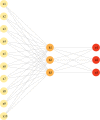Artificial neural networks for simultaneously predicting the risk of multiple co-occurring symptoms among patients with cancer
- PMID: 33350595
- PMCID: PMC7897969
- DOI: 10.1002/cam4.3685
Artificial neural networks for simultaneously predicting the risk of multiple co-occurring symptoms among patients with cancer
Abstract
Patients with cancer often exhibit multiple co-occurring symptoms which can impact the type of treatment received, recovery, and long-term health. We aim to simultaneously predict the risk of three symptoms: severe pain, moderate-severe depression, and poor well-being in order to flag patients who may benefit from pre-emptive early symptom management. This was a retrospective population-based cohort study of adults diagnosed with cancer between 2008 and 2015. We developed and tested an Artificial Neural Network (ANN) model to predict the risk of multiple co-occurring symptoms within 6 months after diagnosis. The ANN model derived from a training cohort was assessed on an independent test cohort for model performance based on sensitivity, specificity, accuracy, AUC, and calibration. The mutually exclusive training and test cohorts consisted of 35,606 and 10,498 patients, respectively. The area under the curve for the risk of experiencing severe pain, moderate-severe depression, and poor well-being were 71%, 73%, and 70%, respectively. Patient characteristics at highest risk of simultaneously experiencing these three symptoms included: those with lung cancer, late stage cancer, existing chronic conditions such as osteoarthritis, mood disorder, hypertension, diabetes, and coronary disease. Patients with over a 40% risk of severe pain also had over a 70% risk of depression, and over a 55% risk of poor well-being. Our ANN model was able to simultaneously predict the risk of pain, depression, and lack of well-being. Accurate prediction of future symptom burden can serve as an early indicator tool so that providers can implement timely interventions for symptom management, ultimately improving cancer care and quality of life.
Keywords: Edmonton Symptom Assessment System; artificial neural network; calibration; co-occurrence; discrimination; model validation; simultaneous prediction; symptom burden.
© 2020 The Authors. Cancer Medicine published by John Wiley & Sons Ltd.
Conflict of interest statement
We declare that we have no conflicts of interest.
Figures



Similar articles
-
Patient-Reported Symptom Severity Among 22,650 Cancer Outpatients in the Last Six Months of Life.J Pain Symptom Manage. 2020 Jan;59(1):58-66.e4. doi: 10.1016/j.jpainsymman.2019.08.016. Epub 2019 Aug 17. J Pain Symptom Manage. 2020. PMID: 31430522
-
Severe symptoms persist for Up to one year after diagnosis of stage I-III lung cancer: An analysis of province-wide patient reported outcomes.Lung Cancer. 2020 Apr;142:80-89. doi: 10.1016/j.lungcan.2020.02.014. Epub 2020 Feb 25. Lung Cancer. 2020. PMID: 32120228
-
Comparing an Artificial Neural Network to Logistic Regression for Predicting ED Visit Risk Among Patients With Cancer: A Population-Based Cohort Study.J Pain Symptom Manage. 2020 Jul;60(1):1-9. doi: 10.1016/j.jpainsymman.2020.02.010. Epub 2020 Feb 21. J Pain Symptom Manage. 2020. PMID: 32088358
-
Telephone interventions for symptom management in adults with cancer.Cochrane Database Syst Rev. 2020 Jun 2;6(6):CD007568. doi: 10.1002/14651858.CD007568.pub2. Cochrane Database Syst Rev. 2020. PMID: 32483832 Free PMC article.
-
Behavioural modification interventions for medically unexplained symptoms in primary care: systematic reviews and economic evaluation.Health Technol Assess. 2020 Sep;24(46):1-490. doi: 10.3310/hta24460. Health Technol Assess. 2020. PMID: 32975190 Free PMC article.
Cited by
-
Artificial Intelligence and Machine Learning in Cancer Pain: A Systematic Review.J Pain Symptom Manage. 2024 Dec;68(6):e462-e490. doi: 10.1016/j.jpainsymman.2024.07.025. Epub 2024 Aug 3. J Pain Symptom Manage. 2024. PMID: 39097246 Free PMC article.
-
Machine Learning Approaches to Predict Symptoms in People With Cancer: Systematic Review.JMIR Cancer. 2024 Mar 19;10:e52322. doi: 10.2196/52322. JMIR Cancer. 2024. PMID: 38502171 Free PMC article. Review.
-
Letter to the editor about "Robot-assisted partial nephrectomy in younger versus older adults with renal cell carcinoma: a propensity score-matched analysis".World J Urol. 2024 Jul 10;42(1):399. doi: 10.1007/s00345-024-05088-w. World J Urol. 2024. PMID: 38985172 No abstract available.
-
Using artificial intelligence to predict patient outcomes from patient-reported outcome measures: a scoping review.Health Qual Life Outcomes. 2025 Apr 11;23(1):37. doi: 10.1186/s12955-025-02365-z. Health Qual Life Outcomes. 2025. PMID: 40217230 Free PMC article.
-
Using real-world electronic health record data to predict the development of 12 cancer-related symptoms in the context of multimorbidity.JAMIA Open. 2024 Sep 12;7(3):ooae082. doi: 10.1093/jamiaopen/ooae082. eCollection 2024 Oct. JAMIA Open. 2024. PMID: 39282082 Free PMC article.
References
-
- Rao A. Symptom management in the elderly cancer patient: fatigue, pain, and depression. J Natl Cancer Inst Monographs. 2004;2004(32):150–157. - PubMed
-
- Miller E, Jacob E, Hockenberry MJ. Nausea, pain, fatigue, and multiple symptoms in hospitalized children with cancer. Oncol Nursing Forum. 2011;38(5):E382–E393. - PubMed
-
- Chochinov HM. Depression in cancer patients. Lancet Oncol. 2001;2(8):499–505. - PubMed
-
- Bubis L, Davis L, Mahar A, Barbera L, Li Q, Moody L, Karanicolas P, Sutradhar R, Coburn N. Symptom burden in the first year after cancer diagnosis: an analysis of patient‐reported outcomes. J Clin Oncol. 2018;36(11):1103–1111. - PubMed
Publication types
MeSH terms
LinkOut - more resources
Full Text Sources
Medical

